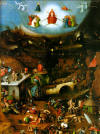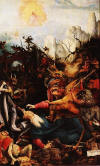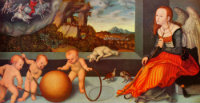Search:: Artists Alphabetically Artists by Country Artists by Century Artists by Movement
Major Painters of the Northern Renaissance
The Northern Renaissance was a time of great intellectual and spiritual awakening. French, German and Netherlandish painters took leadership in the development of a new style of painting while retaining strong Gothic elements within their art-work. The political and religious situation of the region had a profound influence on painters. The ensuing chaos and upheaval of the church meant that there was no single artistic nucleus. Thus there were a number of places where influential art was being created, with regional variations in technique and style.
Important Northern Renaissance Artists
Pieter Brueghel the Younger (1564 - 1638) Flemish
Lucas Cranach the Elder (1472 - 1553) German
Matthias Grünewald (1434-1494) Flemish
Hans Holbein the Younger (1497-1543) German
Rogier van der Weyden (1399-1464) Dutch
Jan van Eyck (1385 - 1441) Flemish
Robert Campin 1375-1444 Dutch
Hans Melming 1434-1494 German
Petrus Christus (1420–1476) Netherlandish
Jan Provoost (1465–1529) Flemish School, Netherlandish
Hugo Van Der Goes (1430-1482)
Joos van Cleve (1485 – 1540) Netherlandish
Joachim Patinir (1480 –1524) Flemish School
Michael Wolgemut (1434–1519) German
Michael Pacher (1435– 1498) Austrian
Colijn de Coter (1445–1532) Netherlandish
Gerard Horenbout (1465 - 1541) Flemish School,
Jean Malouel (1365-1415) French Early Netherlandish
Hieronymus Bosch (1453 - 1516) Dutch
Dieric Bouts the Elder (1413-1475) Dutch
The early 1500s saw the
demise of feudalism and patronage shifted from the super wealthy
nobility and
church to the merchant class. Bankers, businessmen, tradesmen
and
prosperous commomers of the merchant class began collecting and
commissioning works of art. These new patrons favored portraits
and paintings that
included allegories,
humour, satire,
domestic scenes, merchants
at work, peasants in the fields and play,
fantastical
landscapes, dogs, cats, birds, children and household goods.
Italian painters of the era were very interested in the techniques of the Northern painters. Oil painting was discovered in the North and spread quickly to Italy, France and Spain. Famous Northern Renaissance painter, Albrecht Dürer stated "I have many good friends among the Italians who warn me not to eat and drink with their painters, for many of them are my enemies and copy my work in the churches and wherever they can find it; afterwards they criticize it and claim that it is not done in the antique style and say it is no good, but Bellini has praised me highly to many gentlemen. He would willingly have something of mine, and came himself to me and asked me to do something for him, and said that he would pay well for it, and everyone tells me what an upright man he is, so that I am really friendly with him. He is very old and yet he is the best painter of all."
One of the major difference between Italian Renaissance and Northern Renaissance is that Northern painters rejected decadent Greek and Roman influences, focusing more on domestic scenes, satire, and philosophical themes. Humanism was emerging, and religious devotion, though still an important part of people's lives, was being restructured to accommodate the belief that man can be master his own fate.
Differences Between The Northern Renaissance versus Italian Renaissance
The four main technical differences that set the Northern Renaissance painters apart from Italian Renaissance painters is their use of superior paints, painting from direct observation, detailed realism and empirical perspective.Many of the early paintings of the Northern Renaissance perished through time and the fierceness with which the Iconoclastic battles were waged. The Northern Renaissance was different from the Italian Renaissance in many ways. Painters of the North focused upon secular society rather than the Church and overblown religious themes. Northern Renaissance painters emphasis the daily life of the merchant and peasant class. They also put a greater emphasis on devotional piety, spirituality, and living a simple life. Artists such as Dieric Bouts and Peter Brugal the Elder painted inspirational mythology, biblical scenes, the merchant class at work, idyllic scenes of peasants working at everyday tasks, playing games and feasting.
Northern Renaissance painters seemed more in touch with the people. According to art historian John C. Van Dyke "They were perhaps less versatile, less volatile, less like the French and more like the Germans. Fond of homely joys and the quiet peace of town and domestic life, the Dutch were matter-of-fact in all things, sturdy, honest, coarse at times, sufficient unto themselves, and caring little for what other people did. Just so with their painters. They were realistic at times to grotesqueness. Little troubled with fine poetic frenzies they painted their own lives in street, town-hall, tavern, and kitchen, conscious that it was good because true to themselves.."
The Italian Renaissance, on the other hand, focused more on the aristocracy and the theocracy. Painters highlighted the individual and glorified worldly pleasures, Paintings were sumptuous, elaborate, expressive, and exhalted wealthy and powerful people. The Italian Renaissance painters focused heavily on religion, Roman Catholicism. Popes and church hierarchy were wealthy, powerful rulers. Like kings they were depicted in elaborate settings swaddled in furs and silks. Albert Durer noted "The Italians, having before their eyes the treasures of ancient statuary, were able to acquire the purity and correctness of the drawing quickly. They have learned to give their figures this suppleness and elegance of pose, and to clothe them with artistically arranged draperies. The Germans, on the contrary, had only one model: nature. Also if their poses have some stiffness, so their heads are almost all portraits, they great charm and delicious naiveté in expression. In a way, they are closer to the truth."

Important Words, People, Phrases, Characteristics related to the Northern Renaissance Art Movement - allegorical painting, rebirth, invention of oil painting, Hieronymus Bosch, Limbourg Brothers, Desiderius Erasmus, Robert Campin, Jan Van Eyck, Jean Fouquet, Albrecht Dürer, Johannes Gutenberg, Johann Reuchlin, Martin Luther, rise of the merchant class, world landscape, Low Countries, Protestant Reformation, Calvinisim, glazing, impasto, scriptorium, illuminator, invention of the printing press, woodcuts, engravings, Antwerp School, Guild of Saint Luke, commerce, Flemish School, Northern Europe, Flanders, Bruges, renewed interest in classical learning, mythological scenes, genre painting, landscapes, portraits, moralizing overtones, human vices, lust, paradise, spirituality, piousness, living a simple life, reform, Human Reasoning, tradesmen at work, idyllic scenes of peasants, playing games, feasting, linear perspective, \Heliocentric Theory, humour, satire, spiritually significant, illuminated manuscript, idealized biblical themes, scriptorium, emotion, illuminator, iconoclast, Age of Discovery, Virgin and Child, axonometric drawing, curiosity about the natural world, realistic use of colours and light, Old Testament stories, Gospel parables, The Blackdeath, Christian symbolism
If you feel you have worthwhile information you would like to contribute we would love to hear from you. We collect essential biographical information and artist quotes from folks all over the globe and appreciate your participation. When submitting please, if possible, site the source and provide English translation. Please submit your comment to the editor, via e-mail and if possible site the source. Thank you!
© HistoryofPainters.com 2017



